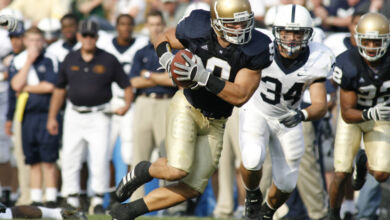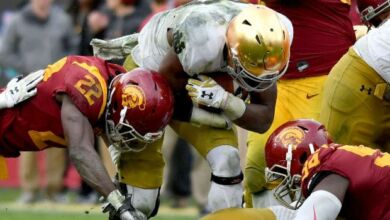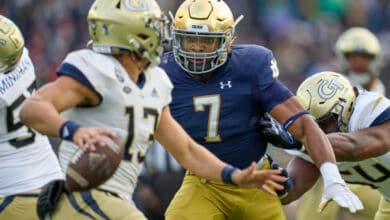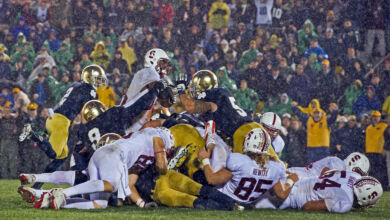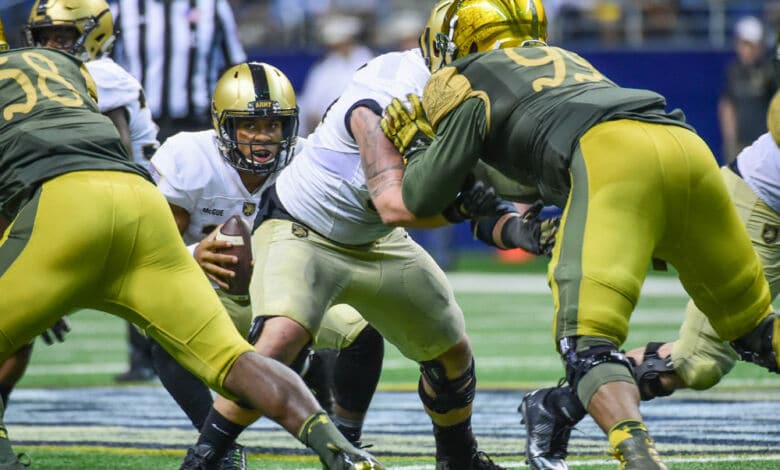
Few rivalries in college football hold the historical significance and mythic grandeur of Notre Dame and the Army. This storied matchup has produced iconic moments, immortalized legends, and shaped the evolution of college football as we know it. With Notre Dame leading the all-time series 38-8-4, the rivalry stretches over a century, beginning in 1913, and continues to echo through time with its dramatic lore and lasting cultural impact.
The 1913 Game: The Forward Pass Revolution
The rivalry was born in 1913 when Notre Dame traveled to West Point to take on the Cadets. That summer, Knute Rockne and Gus Dorais, two Notre Dame undergraduates, had been refining the then-revolutionary concept of the forward pass on the beaches of Cedar Point in Sandusky, Ohio. What unfolded on the field that fall was nothing short of transformative.
Dorais completed an astonishing 14 of 17 passes for 247 yards, bewildering Army’s defense. Rockne himself caught several of those passes, showcasing a new era of football strategy. This groundbreaking performance not only secured a victory for Notre Dame but also etched the series into the annals of football history as a game-changer for the sport.
The Four Horsemen Ride
The most iconic chapter in the Notre Dame-Army saga came on October 18, 1924, at the Polo Grounds in New York City. That day, under a blue-gray October sky, the legendary Four Horsemen—Harry Stuhldreher, Don Miller, Jim Crowley, and Elmer Layden—rode into football immortality.
Grantland Rice’s poetic description of the event immortalized them:
“Outlined against a blue-gray October sky, the Four Horsemen rode again. In dramatic lore their names are Death, Destruction, Pestilence and Famine. But those are aliases.”
Notre Dame triumphed, 13-7, over Army, and the Polo Grounds became a hallowed site in college football history. Notre Dame went on to go undefeated in 1924 en route to claiming the program’s first national championship.
The Game of the Century: 1946
Few games in sports history have garnered the hype and delivered the drama of the 1946 “Game of the Century.” Played at Yankee Stadium, it featured an extraordinary convergence of talent, including four future Heisman Trophy winners—Glenn Davis, Felix “Doc” Blanchard, Johnny Lujack, and Leon Hart.
The game was a defensive masterpiece. Coaches Frank Leahy of Notre Dame and Red Blaik of Army employed conservative strategies, each knowing that the slightest mistake could determine the outcome. The game ended in a legendary 0-0 tie, yet it captured the imagination of a nation still basking in the glow of victory in World War II. It remains one of the most celebrated games in college football history.
Reemergence in Modern Times: The 1995 Thriller
The rivalry made a dramatic return in 1995, a game etched in Notre Dame lore not just for its outcome but for a moment of sheer determination. Played in the Meadowlands in New Jersey, the Fighting Irish found themselves clinging to a narrow 28-27 lead late in the fourth quarter after Army mounted a furious comeback and was poised to score a two-point conversion to claim victory.
Enter Ivory Covington. The Notre Dame defensive back delivered a perfectly timed, bone-jarring tackle at the one-yard line, preserving the victory for the Irish. Covington’s heroic effort symbolized the grit and determination that have defined the rivalry for decades. The win kept Notre Dame’s bowl coalition hopes alive, and the Irish ended the 1995 campaign in the Orange Bowl.
New York City: The Stage of Legends
Over the years, the rivalry has been intertwined with the grandeur of New York City. Army and Notre Dame first played in the Polo Grounds, with its sweeping views of the Harlem River, creating an epic backdrop for the Four Horsemen’s exploits. Later, Yankee Stadium hosted many of the series’ most memorable clashes, including the 1946 Game of the Century and the 2010 Shamrock Series during Brian Kelly’s first season as head coach. These iconic venues added a layer of majesty to the games, blending the mystique of the sport with the energy of the nation’s greatest city. The rivalry returns to Yankee Stadium in 2024, with the Fighting Irish and Black Knights squaring off in another Shamrock Series contest.
The Legacy Lives On
While the Notre Dame-Army rivalry has become less frequent in modern times, with Army no longer a powerhouse, its legacy endures. The series ran uninterrupted from 1913 to 1947 and was critical in elevating college football to national prominence. It showcased the talent, innovation, and passion that defined an era.
Notre Dame’s dominance in the rivalry has not diminished its competitive spirit or historical significance. Each meeting rekindles memories of Rockne and Dorais on the beaches of Cedar Point, the Four Horsemen galloping into legend, and the roar of 1946 at Yankee Stadium.
The rivalry is more than a series of football games; it is a tapestry woven with the threads of American history, innovation, and sheer love of the sport. Whenever these two teams meet again, their clash will surely inspire new dreams while celebrating the enduring legacy of one of college football’s greatest rivalries.
“On Brave Old Army Team.”
